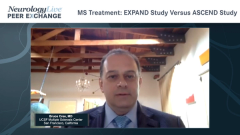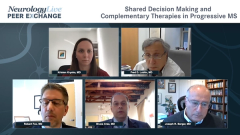
Ibudilast for Progressive Treatment
Experts in progressive multiple sclerosis summarize the phase 2 SPRINT-MS trial and the rationale for treating patients with ibudilast.
Episodes in this series

Bruce Cree, MD: Bob, I’m going to ask you to summarize the ibudilast study that you were the principal investigator on, and comment on neuroprotection. I want you to define what neuroprotection is. Tell us whether you think ibudilast is a neuroprotective drug and whether we’ll ever see application of this in progressive forms of MS [multiple sclerosis].
Robert Fox, MD: Sure. What we’ve been getting at throughout this program is that progressive MS can have active inflammation, relapses, and new lesions on MRI, but a lot, if not the majority, of the progressive aspects of progressive MS are not that. It is something else. It is this gradually insidious pathophysiology that’s leading to a gradual decline in our patient’s function. The therapies we’ve talked about today have been certainly able to target the inflammation. It’s a little less clear whether they target that other aspect.
Ibudilast is a therapy that tried to target that other aspect. It is an orally absorbed medication. It’s approved in many countries in Asia to treat asthma and post-stroke symptoms. The mechanism of action is a little unclear in the central nervous system, but it does have an inhibitory effect on several cyclic nucleotide phosphodiesterases. Also, macrophage migration inhibitory factor and toll-like receptor 4. These are different cellular pathways that may be related to neurodegenerative processes that may be going on in progressive MS.
SPRINT-MS was a placebo-controlled trial that randomized patients to up to 100 mg a day of ibudilast compared to placebo. It followed patients over 2 years. The primary outcome was progression of whole-brain atrophy with secondary outcomes, including cortical atrophy, advanced MRI measures such as MTR [magnetization transfer ratio] and diffusion tensor imaging, and retinal nerve fiber layer thickness, as measured by OCT [optical coherence tomography].
The primary outcome was met, in that ibudilast-treated patients had about a 50% slowing in progression of whole-brain atrophy. There was also a slowing in progression of cortical atrophy and a decline in magnetization transfer ratio. There were trends seen in OCT and diffusion tensor imaging consistent with a protective effect, although not statistically significant.
Importantly, there was no reduction in the few relapses seen in these progressive patients, and there was no reduction in the new T2 lesions seen on MRI. This is one of the few therapies that were targeting that other aspect. Even though it did not slow the number of new lesions or disease activity, it did reduce or slow the evidence of neurodegeneration, as measured by things like atrophy and MTR.
As for its next steps, that was a phase 2 trial. You can’t get regulatory approval based on just MRI outcomes. It is waiting to go into a phase 3 trial. I have not heard any further updates regarding the company that has the IP [investigational product] interest in ibudilast in terms of moving forward into a phase 3 trial. We’re still waiting for that next step: the definitive phase 3 trial for that drug.
Bruce Cree, MD: Thank you for watching NeurologyLive® Peer Exchange. If you enjoyed the content, please subscribe to our e-newsletters to receive upcoming Peer Exchanges and other great content right in your inbox.
Transcript Edited for Clarity
Newsletter
Keep your finger on the pulse of neurology—subscribe to NeurologyLive for expert interviews, new data, and breakthrough treatment updates.




















































